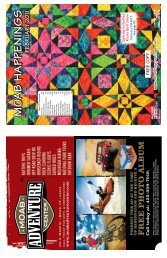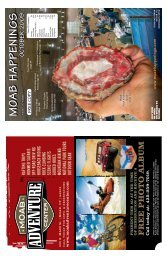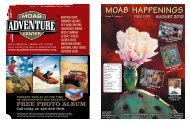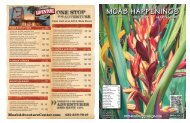Moab Happenings
Moab Happenings
Moab Happenings
Create successful ePaper yourself
Turn your PDF publications into a flip-book with our unique Google optimized e-Paper software.
www.moabhappenings.com<br />
HIKING HAPPENINGS<br />
<strong>Moab</strong> <strong>Happenings</strong> • March 2011 • 13A<br />
Hidden Valley – An Ancient Hangout Story and photos by Marcy Hafner<br />
The extensive display of rock art etched on the<br />
Navajo Sandstone walls in Hidden Valley is a strong clue<br />
that a lot of activity occurred here a long, long time ago.<br />
Evidence of habitation and heavy foot traffic would also<br />
suggest that this valley was used as a social and ritual<br />
center - a popular gathering place, a local hangout for<br />
the prehistoric Basketmaker people.<br />
Some historians believe that 25,000 years ago,<br />
during the last Pleistocene Ice Age, a human migration<br />
took place over The Bering Land Bridge – a passage<br />
between Alaska and Siberia that existed during that<br />
time. It is well established that a major migration did<br />
occur 12,000 to 15,000 years ago when humanity spread<br />
rapidly throughout North, Central and South America.<br />
The first evidence of a prehistoric people in southeast<br />
Utah can be traced back<br />
to around 6,000 B. C.<br />
Constantly on the move,<br />
these bands of hunter/<br />
gatherers were known<br />
as the Desert Archaic<br />
(sometimes referred<br />
to as Barrier Canyon).<br />
These nomads left little<br />
behind of their legacy<br />
except for the rock<br />
images they pecked and<br />
painted on the sandstone<br />
canyon walls.<br />
The Basketmakers<br />
replaced or evolved<br />
from the Archaic around<br />
0 A.D. During their domain, which<br />
only lasted 800 to 900 years,<br />
they were prolific artists and the<br />
majority of rock art that still exists<br />
in Hidden Valley is associated<br />
with these people. Unlike their<br />
predecessors, the Basketmakers<br />
became a semi-agrarian society.<br />
Over an extended period of time<br />
their culture gradually transformed<br />
into the era of the modified<br />
Basketmakers, and they settled<br />
down to build their pithouses over<br />
shallow excavations in the ground.<br />
As farmers, they lived in small clans tending their fields<br />
of squash and corn - the granaries for the storage of their<br />
corn still exist today. Agriculture, however, did not meet<br />
all their dietary needs and the hunter/gatherer tradition<br />
continued, with the more efficient bow and arrow slowly<br />
replacing the atlatl.<br />
Over time they perfected the craft of weaving<br />
willow rods, yucca fibers and human hair into functional<br />
baskets. When they mastered the technique of tightly<br />
weaving the fibers to make their containers waterproof,<br />
their lives changed dramatically. Now they could drop<br />
hot stones into the water until it boiled. Just imagine a<br />
menu that now included the nourishing meals of soup<br />
and stew!!<br />
To get to the Hidden Valley Trailhead, from Center<br />
and Main Street drive south on Highway 191 three and a<br />
half miles. At the stucco dental office building turn right<br />
on to Angel Rock Road and drive several blocks until<br />
it dead ends. Then turn right on to Rimrock Road and<br />
continue the short distance to the trailhead.<br />
From the parking area it is puzzling as to where<br />
Hidden Valley must be sequestered; broken rocky<br />
cliffs keep it hidden from view. A daunting series of<br />
switchbacks – a definite bike carry route - snake their<br />
way 680 vertical feet up the steep rubbly trail to the<br />
1.3 mile length of the valley, which is bordered on the<br />
southwest by massive Wingate Sandstone cliffs.<br />
After my successful navigation through the jumping<br />
jack, big-rock obstacle course to the top, I plop down for<br />
a “grateful that my body is still intact” break! Relaxing on<br />
my high-ended platform, I savor the bird’s-eye view and<br />
pick out so much that is familiar – Spanish Trail Arena,<br />
Highway 191, White’s Ranch, Spanish Valley Drive, the<br />
<strong>Moab</strong> Golf Course and the OK RV Park. Beyond the<br />
greenness of Spanish Valley, my searching gaze lingers<br />
on the entire range of the La Sal Mountains – a haunting<br />
white-mantled profile on the southeast horizon.<br />
Finally getting up, I move along behind the rim on a<br />
short uphill section into a forest of pygmy-sized junipers<br />
where the trail passes the boundary of Behind The Rocks<br />
Wilderness Study Area. On the gentle decline, the entire<br />
brushy, grassy bottom of Hidden Valley stretches ahead<br />
with a wide level dirt path that<br />
is so easy on the feet, the knees<br />
and the lungs!<br />
Now I intently listen for the<br />
“chuk-chuk-chuk” alarm call<br />
of the chukar, an upland game<br />
bird that was introduced to the<br />
intermountain west from the<br />
Middle East. These chicken-<br />
sized ground<br />
dwellers, which are<br />
the national bird of<br />
Pakistan, thrive on<br />
rocky hillsides with a good supply of grassy vegetation,<br />
and Hidden Valley obviously appeals to them.<br />
When disturbed, these skittish birds prefer to run<br />
uphill, but when their cover is completely blown, they<br />
take off in a frenzied short distance whirl of wings. I<br />
seldom get a close-up look at these flighty birds, but<br />
sometimes, on a lucky day they’ll hold tight long enough<br />
for an in depth observation of their distinctive markings<br />
- the bright red bill and legs and the white throat that is<br />
decorated with a black necklace. On an extremely lucky<br />
day I’ll even experience that rare opportunity to watch<br />
the parents with their young, who are able to leave the<br />
nest shortly after hatching. The most bizarre episode<br />
occurred as I was driving down Rimrock Road – feeling<br />
like a sheep dog, I herded the adults and youngsters in<br />
front of me until it finally dawns on this confused and<br />
frazzled flock to get off the road!!<br />
At an obvious hump in the trail, which quickly<br />
drops down to join the <strong>Moab</strong> Rim Jeep Trail, the horizon<br />
suddenly opens up to an expansive view of Poison<br />
Spider Mesa, Island In The Sky and a huge series of fins<br />
and cliffs that rise above the Colorado River. At the top<br />
THE NEW SEASON IS HERE<br />
����������������������������������<br />
�������������������������<br />
�������������������<br />
435-259-7238<br />
805 North Main St.<br />
www.moab-rafting.com<br />
email: info@ moab-rafting.com<br />
of this mini-pass, I take a right to follow a distinctive<br />
footpath, which leads to a south facing Navajo Sandstone<br />
wall with a huge gallery of fascinating petroglyphs that<br />
have been on display for over a thousand years.<br />
These imaginative panels overflow with the creative<br />
figures of deer, animal tracks, odd shaped human figures<br />
(some with big ears,) long lines of hand holders, tribal<br />
head dresses, hand and foot impressions, necklaces,<br />
symmetrical lines and dots, big cat-like depictions – as<br />
well as plenty of bighorn sheep, which<br />
were undoubtedly a major food source in<br />
their lives.<br />
In the summer, shade on the Hidden<br />
Valley Trail departs in a hurry very<br />
early in the morning and it heats up fast.<br />
Ironically, in the winter the rim blocks the<br />
rays of the low hanging sun for most of<br />
the day. Consequently when it snows, it<br />
becomes a treacherous slide-on-ice walk,<br />
which I avoid.<br />
This close-to-town four mile round<br />
trip exploration is ideal in the spring and<br />
fall when you can comfortably enjoy its<br />
prehistoric past. During your outing, you<br />
can linger for a contemplation of the<br />
significance and meaning of all this rock<br />
art that has survived for centuries within its protective<br />
walls. I always wonder what the objective could possibly<br />
have been for all these glyphs - Creative story telling?<br />
Cultural and spiritual expression? A depiction of their<br />
daily activities? A recording of visions? Or just an<br />
artistic outlet? The answers are buried with the ancient<br />
artists.<br />
FULL SERVICE<br />
FITNESS CENTER<br />
��������<br />
�������<br />
�������<br />
Fitness Director is a former trainer<br />
for Arizona Diamondbacks<br />
5am - 1am<br />
7 days a week<br />
www.moabgym.com<br />
������<br />
������<br />
��������<br />
����<br />
•22 Cardio Machines • Free Weights<br />
Weight Machines • Aerobics • Spinning<br />
��������������������������������������������<br />
��������������������������������������������������������<br />
������������������������������������������<br />
1070 S. Hwy. 191<br />
435.259.5775<br />
info@moabgym.com








